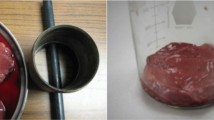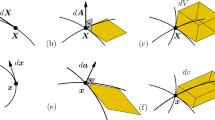Abstract
Realistic surgical simulation requires incorporation of the mechanical properties of soft tissue in mathematical models. In actual deformation of soft-tissue during surgical intervention, the tissue is subject to tension, compression, and shear. Therefore, characterization and modeling of soft-tissue in all these three deformation modes are necessary. In this paper we applied two types of pure shear test, unconfined compression and uniaxial tension test to characterize porcine liver tissue. Digital image correlation technique was used to accurately measure the tissue deformation field. Due to gravity and its effect on the soft tissue, a maximum stretching band was observed from the relative strain field on sample undergoing tension and pure shear test. The zero strain state was identified according to the position of this maximum stretching band. Two new constitutive models based on combined exponential/logarithmic and Ogden strain energy were proposed. The models are capable to represent the observed non-linear stress–strain relation of liver tissue for full range of tension and compression and also the general response of pure shear.












Similar content being viewed by others
References
Brown, J. D., J. Rosen, M. N. Sinaman, and B. Hannaford. In vivo and postmortem compressive properties of porcine abdominal organs. In: Medical Image Computing and Computer-Assisted Intervention, MICCAI 2003, No. 2878 in Lecture Notes in Computer Science, 2003, pp. 238–245.
Butler, D. L., E. S. Grood, F. R. Noyes, R. F. Zernicke, and K. Brackett. Effects of structure and strain measurement technique on the material properties of young human tendons and fascia. J. Biomech. 17(8):579–596, 1984.
Carter, F., T. Frank, P. Davies, D. McLean, and A. Cuschieri. Measurements and modelling of the compliance of human and porcine organs. Med. Image Anal. 5:231–236, 2001.
Charlton, D., J. Yang, and K Teh. A review of methods to characterize rubber elastic behavior for use in finite element analysis. Rubber Chem. Technol. 67:481–503, 1994.
Chui, C., E. Kobayashi, X. Chen, T. Hisada, and I. Sakuma. Combined compression and elongation experiments and non-linear modelling of liver tissue for surgical simulation. Med. Biol. Eng. Comput. 42(6):787–798, 2004.
Chui, C., E. Kobayashi, X. Chen, T. Hisada, and I. Sakuma. Transversely isotropic properties of porcine liver tissue: experiments and constitutive modelling. Med. Biol. Eng. Comput. 45(1):99–106, 2007.
Davies, P. J., F. J. Carter, and A. Cuschieri. Mathematical modelling for keyhold surgery simulations: a biomechanical model for spleen tissue. IMA J. Appl. Math. 67:41–67, 2002.
Dokos, S., I. J. LeGrice, B. H. Smaill, J. Kar, and A. A. Young. A triaxial-measurement shear-test device for soft biological tissues. J. Biomech. Eng. 122:471–478, 2000.
Dokos, S., B. H. Smaill, A. A. Young, and I. J. LeGrice. Shear properties of passive ventricular myocardium. Am. J. Physiol.-Heart Circ. Physiol. 283:H2650–H2659, 2002.
Farshad, M., M. Barbezat, P. Flueler, F. Schmidlin, P. Graber, and P. Niederer. Material characterization of the pig kidney in relation with the biomechanical analysis of renal trauma. J. Biomech. 32:417–425, 1999.
Fung, Y. C. Biomechanics: Mechanical Properties of Living Tissues. New York: Springer, 1993.
Gao, Z., and J. P. Desai. Estimating zero strain states of very soft tissue under gravity loading using digital image correlation. In review.
Gao, Z., K. Lister, and J. P. Desai. Constitutive modeling of liver tissue: experiment and theory. In: Second Biennial IEEE/RAS-EMBS International Conference on Biomedical Robotics and Biomechatronics, BioRob 2008, 2008, pp. 477–482.
Gardiner, J. C., and J. A. Weiss. Simple shear testing of parallel-fibered plannar soft tissues. J. Biomech. Eng. 123:170–175, 2001.
Guo, D. L., B. S. Chen, and N. S. Liou. Investigating full-field deformation of planar soft tissue under simple-shear tests. J. Biomech. 40(5):1165–1170, 2007.
Ham, A. W. Histology (6th ed.), Chap. Pancreas, Liver and Gallbladder. Philadelphia and Toronto: J. B. Lippincott Company, pp. 711–717, 1969.
Hollenstein, M., A. Nava, D. Valtorta, J. G. Snedeker, and E. Mazza. Biomedical Simulation, Lecture Notes in Computer Science, Vol. 4072, Chap. Mechanical Characterization of the Liver Capsule and Parenchyma. Berlin/Heidelberg: Springer, pp. 150–158, 2006.
Hu, T., and J. P. Desai. Modeling large deformation in soft-tissues: experimental results and analysis. In: EuroHaptics. Munich, Germany, 2004.
Hu, T., C. Lau, and J. P. Desai. Instrumentation for testing soft-tissue undergoing large deformation: ex vivo and in vivo studies. ASME J. Med. Devices 2(4):041001-1–041001-6, 2008.
Jordan, P., S. Socrate, T. Zickler, and R. Howe. Constitutive modeling of porcine liver in indentation using 3d ultrasound imaging. J. Mech. Behav. Biomed. Mater. 2:192–201, 2009.
Kerdok, A. E., M. P. Ottensmeyer, and R. D. Howe. Effects of perfusion on the viscoelastic characteristics of liver. J. Biomech. 39:2221–2231, 2006.
Mazza, E., A. Nava, D. Hahnloser, W. Jochum, and M. Bajka. The mechanical response of human liver and its relation to histology: an in vivo study. Med. Image Anal. 11:663–672, 2007.
Miller, K. Constitutive modelling of abdominal organs. J. Biomech. 33:367–373, 2000.
Miller, K., and K. Chinzei. Constitutive modelling of brain tissue: experiment and theory. J. Biomech. 30:1115–1121, 1997.
Miller, K., and K. Chinzei. Mechanical properties of brain tissue in tension. J. Biomech. 35(4):483–490, 2002.
Miller, K., Z. Taylor, and W. L. Nowinski. Towards computing brain deformations for diagnosis, prognosis and neurosurgical simulation. J. Mech. Med. Biol. 5(1):105–121, 2005.
Nava, A., E. Mazza, M. Furrer, P. Villiger, and W. Reinhart. In vivo mechanical characterization of human liver. Med. Image Anal. 12:203–216, 2008.
Ogden, R. Large deformation isotropic elasticity—on the correlation of theory and experiment for incompressible rubberlike solids. Proc. R. Soc. Lond. Ser. A 326:565–584, 1972.
Paulsen, K. D., M. I. Miga, F. E. Kennedy, P. J. Hoopes, A. Hartov, and D. W. Roberts. A computational model for tracking subsurface tissue deformation during stereotactic neurosurgery. IEEE Trans. Biomed. Eng. 46(2):213–225, 1999.
Roan, E., and K. Vemaganti. The nonlinear material properties of liver tissue determined from non-slip uniaxial compression experiments. J. Biomech. Eng. 129:450–456, 2007.
Saraf, H., K. Ramesh, A. Lennon, A. Merkle, and J. Roberts. Measurement of the dynamic bulk and shear response of soft human tissues. Exp. Mech. 47:439–449, 2007.
Shuck, L. Z., and S. H. Advani. Rheological response of human brain tissue in shear. J. Basic Eng. 94(4):905–911, 1972.
Valtorta, D., and E. Mazza. Dynamic measurement of soft tissue viscoelastic properties with a torsional resonator device. Med. Image Anal. 9:481–490, 2005.
Vito, R. P., and S. A. Dixon. Blood vessel constitutive models—1995–2002. Annu. Rev. Biomed. Eng. 5:413–439, 2003.
Acknowledgment
This work was supported by the National Institutes of Health (NIH) under Grant 1R01EB006615.
Author information
Authors and Affiliations
Corresponding author
Additional information
Portions reprinted, with permission, from: “Zhan Gao, Kevin Lister, and Jaydev P. Desai, 2008. Constitutive modeling of liver tissue: experiment and theory. In: 2nd IEEE RAS & EMBS International Conference on Biomedical Robotics and Biomechatronics, BioRob 2008, pp. 477–482, October 19–22, 2008, Scottsdale, AZ” ©2008 IEEE.
Portions reprinted, with permission, from: “Zhan Gao, Theodore Kim, Doug L. James, Jaydev P. Desai, 2009. Semi-automated soft-tissue acquisition and modeling for surgical simulation. In: 5th Annual IEEE Conference on Automation Science and Engineering, CASE 2009, pp. 268–273, August 22–25, 2009, Bangalore, India.” ©2009 IEEE.
Rights and permissions
About this article
Cite this article
Gao, Z., Lister, K. & Desai, J.P. Constitutive Modeling of Liver Tissue: Experiment and Theory. Ann Biomed Eng 38, 505–516 (2010). https://doi.org/10.1007/s10439-009-9812-0
Received:
Accepted:
Published:
Issue Date:
DOI: https://doi.org/10.1007/s10439-009-9812-0




